The Controversial Microwave

Within the "traditional foods movement", microwaves are often eschewed. I have come down on this issue in a different place than most and am going to discuss in this post why I do not think microwaves are evil.
microwaves & language issues
Much of the anti-microwave sentiment expressed is badly-worded language designed to make people without much of a science background feel nervous.
For example, it is said that microwaves heat food by using RADIANT ENERGY. But all light is radiant energy, from the sunlight allowing your skin to make vitamin D to the most basic cooking of all, over a campfire like our ancestors did all their cooking. The entire light spectrum is radiant energy! However, by saying it as if it's a scary word, there is the hope you will vaguely misunderstand and think that microwave ovens are radioactive, which is not the case.
cooking under pressure

(with accompaniment by the Piano Man)
by Jackie PattiWithin the real food movement, pressure cookers are not as controversial as microwaves, but not nearly as beloved as crockpots.
Health-wise, what we know is that pressure cooking destroys lectins, a class of anti-nutrients, found in grains and beans. reference
Personally, I find a pressure cooker just ROCKS my kitchen.
how to get a bunch of meals from a half ham

There are a bazillion sites out there that tell you how to get 3 or 4 meals out of a whole chicken. I am going to tell you how to get 10-15 meals out of a half ham.
A ham is basically the butt and top bit of the leg off a pig, from the hip to the knee. This big piece is then cured and smoked to produce ham. Whether you get pastured pork, "uncured" ham without nitrates, or regular grocery-store stuff, you can usually get the best deal buying a half ham.
how to accomplish things when you're tired and in pain

Ironically, I started writing this post before my two trips to Texas, 2 weeks in March and 4 weeks in April, that have left me very fatigued again through May, and thus quite late with this post!
There's 3 important reasons for me to continue to do as much as I can in spite of my disability:
- the feeling of accomplishment
- to retain and regain abilities
- to avoid boredom
One of the big tricks of being able to do things while disabled has been to break tasks down into the smallest steps. This is why I can grow a garden of tomatoes, make sauce and can it, but risotto is hard for me. Risotto has a half hour where I have to stand and stir constantly, I can't break that down any further. But almost everything else, I can break down into small 5-10 minute steps.
I am going to illustrate what I mean with the simple task of doing the dishes:
Gluten-Free Snacks e-cookbook - launch & flash sale
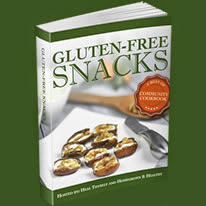
The largest problem folks have when they first go gluten-free, whether to treat celiac or non-celiac gluten sensitivity, is replacing all the ordinary gluteny foods with store-bought gluten-free junk food.
There's three problems with this. First off, junk food remains junk food even when it's gluten-free. Second, the stuff is massively overpriced. And finally, if I'm going to eat budget-busting junk food, it should at least TASTE good and most gluten-free stuff doesn't even come close to qualifying.
You pretty much have to do some cooking to survive a gluten-free diet with your health, wallet and taste buds intact.
if you really can't make broth

I recently posted about why I can't live without my homemade broth. For me, broth is second only to real pastured butter on my must-have's for both health and lusciousness.
However, in the spirit of my posts for Pat series, I admit everyone can't make homemade broth all the time.
I still encourage you to make broth when you can. Simmering a turkey carcass is easier than cleaning the roasting pan. A chicken carcass is small enough to be brothed in a crockpot, which means you won't have to babysit a stockpot.
But if you can't make enough to eat stock REGULARLY, which is crucial to good health, I have two possible solutions for you.
why bother cooking at all?
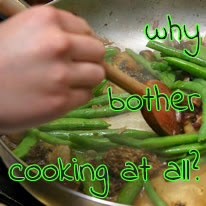
There is something inside me that finds sourcing good ingredients, preparing and cooking them, and providing my handiwork to an appreciative audience profoundly satisfying.
That is why I cook, I enjoy it and it feels good to me. I can justify it in all sorts of ways, but really, it feels good.
I have a hard time explaining to someone who doesn't have the same feelings about it why they should do it, but I'll give it a shot.
I must have my broth

That is a simple, basic fact of my life.
It all began with roasting my first turkey. After stashing the leftovers in the fridge and doing the dishes, I faced the roasting pan. It was full of the excess pan juices I hadn't used in making gravy, there were a lot of little bits of the meat that had been too fiddly to pull off the carcass and the roasting pan was too big to fit in my tiny apartment sink. So my solution to all of this was to fill the pan with water, throw in whatever spare carrots, celery, onions or parsley I had lying around, put it over 2 stove burners and simmer until broth happened.
I loved broth. My favorite comfort food all through college and graduate school was to cook a box of orzo, pastina, stelline or alphabets in broth so that the pasta cooked through just as it absorbed all the broth. I knew nothing about broth being a healthy food, and in fact, felt vaguely guilty when I ate a meal that consisted primarily of white flour. But I knew a bowl of teeny tiny pasta cooked in broth and covered with Parmesan made me feel good from my taste buds all the way down to my socks.
braised green beans

Personally, I like green beans just fine simply steamed and dressed with loads of butter. I also like them dressed with olive oil and garlic. I don't think cooking green beans needs to be complicated.
Garlic is a theme for me with green beans. If I am more ambitious than just steaming, I like them roasted with garlic. Or another favorite green bean recipe is to stir-fry them with garlic. However, no matter how I make them, hubby just didn't like them until this recipe, now he eats them!
It's not particularly difficult, but must simmer for a half hour, so it fits into my repertoire best when I have just put something into the oven that will take an hour or so, like a meatloaf.
It works well with ordinary whole green beans or with Romano-type green beans. Frozen beans work well too, but you really want them to be whole, not cut.
March/April link love

The biggest news in my world over the March-April time period was that Deductive Seasoning was on hiatus in April. This was due to my daughter's illness, which began in December as a diverticulitis flare and ended in April with surgery, with a detour through antibiotic-induced delirium that was extremely unnerving for everyone involved.
Several trips to Texas resulted with very little time for blogging what with hanging out at a hospital all day and night. During the blog's hiatus, Google recorded nearly as many hits as when I have a new post up every 3 days, causing me to wonder if I really need to write or not!
In non-blog news, we lost a plane. We keep mistaking trash in the ocean for debris as apparently there's a lot of trash in the ocean. The plane is just completely missing.
Russia took a bite out of the Ukraine, which is apparently not as good as taking a bite out of crime-a. Much wailing and gnashing of teeth seems to have occurred, but no actual consequences. A bunch of nuns were heard singing, 'How do you solve a problem like Crimea?'
blog on hold
Turns out when your kid is 30, you're still primarily a mom.
My daughter's having a huge health crisis and needs me. I'll be updating my Google+ page for those who want to follow along.
I'm leaving for TX tomorrow and will be offline for several weeks. Once I land, and have some free time, I will likely be typing the whole mess into my G+ account just to be able to vent.
But the blog itself is just completely on hold for a few weeks; other than piles of turkey soup and homemade gelatin made from juice, no real food is happening.
real food for busy women: when you really can't cook
This series, "posts for Pat" is inspired by my friend Pat, who lives a life where frugality is better applied to time than to finances; hence it's sub-title: "real food for busy women".
We've covered several topics thus far: why you need a crockpot with the world's easiest crockpot recipe, how keeping a fruit bowl improves your nutrition just by spending a few minutes in the produce section when you grocery shop, a roundup of crockpot recipes that can cook all day unattended, and a bizarre post in which I timed a vegetarian recipe to see if I could make it in 15 minutes.
Today we're going to cover how to eat well when you really, truly have NO time to spend in the grocery store let alone the kitchen.
You know the week, we've all had them. The big project is due next week, and there's no telling how much overtime there'll be. An 8-10 hour window on a crockpot meal won't work; you'll be working 12-14 hour days. You REALLY, REALLY can't do anything about food this week...
butter is a true superfood

As a survivor of a big, ol' unpleasant heart attack (with an unsuccessful angioplasty and subsequent CABG, followed by years of disability), one of my primary strategies to avoid a recurrence is to eat stupid amounts of butter. Luckily, butter is utterly delicious, so this is no hardship.
I have been babbling about butter as a superfood for some time, with a particular emphasis on pastured butter, so it startled me a tad when I began this post and found the research hard to find. The USDA database has an entry for ordinary butter, but nothing on the grass-fed stuff. It took a day in PubMed finding the original references to justify the advice I've been giving for years now as well as my own ridiculous butter consumption.
But before we get to discussing the benefits of the pastured stuff, let's just start with plain ordinary butter, which has many advantages in and of itself.
eating seasonally in spring

For me, spring fruits and vegetables do for my taste buds what daffodils, dandelions and johnny jump ups do for my soul. Spring is just so celebratory for me, especially after such a nasty winter as this one was. I laugh at the least provocation, my energy levels rise and I feel all bouncy, the world is full of such promise... and there are sugar snap peas.
The reasons for eating seasonally are several: seasonal vegetables are more likely to be locally produced rather than shipped for long distances, foods in season tend to be more abundant and thus great bargains can be had and finally, foods are just yummiest when freshest.
about me

It occurred to me that every blog in the whole world has an "about me" page except mine; so here you go!
I have both fatigue and pain issues that are ongoing.
Some days, you'd hardly believe I was disabled at all, I do things just like a normal person, running around in the garden, mowing the lawn, cooking up a storm in the kitchen.
Other days, I need assistance getting dressed and can sit for several hour thirsty, too tired to get up and get a drink.
Contest Results: Grocery Time

I've been a fan of Mark's Daily Apple for quite a long time. If you don't know the blog, Mark basically invented the "Primal" diet, which is sort of paleo with dairy added.
Mark espouses the 80:20 principle of eating: basically to eat well 80% of the time and compromise a bit around the edges the other 20% of the time, as more realistic than aiming for perfection.
Mark does a lot of contests on his blog and because he has a large readership, gets huge numbers of entries. This particular contest involved sending in a picture of a week's worth of groceries; the winner was chosen by random drawing, so it didn't matter if your picture included processed foods or not. For this contest, he specifically instructed his readers to send in REAL pictures, not idealized ones, which makes the results even more intriguing...
stir fry vegetables with eggs
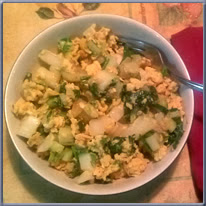
This stir fry vegetables and eggs recipe was created by serendipity. I'm going to give you the back story of how it came about to show you the weird and wonderful way a blogger's mind works. I think the story is entertaining, but if you want, you can just scroll to the end of the page and grab the recipe.
- While researching and thinking about starting the Pats for posts: real food for busy women series, I ran across Jamie Olivier's 15-Minute Meals. Though I don't watch his show, I'd seen his Ted talk, and knew he was a proponent of better nutrition. So I watched a few of his videos thinking they might be helpful for my series, but they really weren't. Each video begins with mise en place, which is French for "I have someone to cut and measure everything for me before the camera is turned on." Jamie himself is a young and healthy guy who pretty much bops around the kitchen with more energy than I ever had after a long day at work. And finally, he finishes up with so many pots and pans dirtied that it's going to take some serious time to repair that kitchen if you don't have staff. So while the concept of preparing a meal in 15 minutes was attractive, my understanding of what it would take to translate those videos in my own kitchen was more like an hour.
healthy cornbread
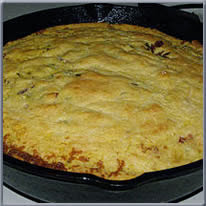
As promised in my post about my plans for planting corn and corn nutrition, here is my simple cornbread recipe.
This homemade cornbread recipe produces a real cornBREAD, not crumbly stuff only suited for crumbling into a bowl of pinto beans. This stuff holds together well enough to make sandwiches, though admittedly long, skinny ones.
This is also a real CORNbread, not your typical wheat bread flavored with some cornmeal. Thus it's gluten-free.
Finally, this CORNBREAD is not an abomination with sugar that tastes more like cake than cornbread.
And while I think this is a relatively healthy cornbread, it is the yummiest freaking cornbread I ever tasted.
how to cook dry beans

Canned beans are nutritionally problematic because they are not soaked to reduce phytic acid, yet the high heat processing reduces phytase so there's no hope of reducing it through other means.
Dry beans can be prepared so as to minimize the phytic acid and even the lectin content and are a more frugal way to add beans to your diet.
The problem is, dried beans aren't convenient. They involve planning ahead, so you can't just make some bean-layer dip right now. Maybe you have a hankering for chili, but didn't start soaking beans two days ago.
I am going to share with you a kitchen tip that will make cooking dried beans just as convenient as canned beans - and it's easy! In 5 minutes a day for a week, I make enough cooked beans to last for MONTHS!
planting and growing corn for nutrition

I suspect we don't think of corn as a useful grain because we're all so accustomed to avoiding it on processed food labels: HFCS, modified corn starch, corn oil. Or we're accustomed to thinking of it as that cheap subsidized stuff they feed to cows and chickens instead of pasture to make nutritionally-deficient CAFO meat, eggs and dairy. And we know that the majority of the corn crop in this country is GMO. In short, we tend to think of corn as "bad stuff" except for a few ears of sweet corn in summer.
But corn can be a great addition to the diet, unless you are allergic or eat grain-free. Corn has a rather high protein content for a grain (14% on a dry grain basis). And while rarely included in the lists, it is a gluten-free grain.
Corn is often ignored by gardeners, though some of us grow a small patch of sweet corn for summer enjoyment. But corn is the only grain that it's reasonable to grow and process on a small-scale. It can be harvested, husked and shelled with hand tools; no combines required. Corn is the only grain you can reasonably be self-sufficient in, something particularly worth considering if you're a gardener with celiac or NCGS.
But in order for corn to become a useful part of the diet, we have to learn how to use it properly. Native Americans didn't process it into HFCS; settlers didn't bake with modified corn starch; the colonists didn't press it into corn oil. We need to learn how to make REAL cornbread (which has no wheat flour), sweet breads, polenta, johnnycake, sponge cake, parched corn, hominy, tortillas, and corn gravy. All are possible if we learn how to use the appropriate types of corn.
February Favorites - 2014

February was darned cold here, with another stupid amount of snow falling, but given this is the third month of this ridiculous snow and cold, I guess it's not news anymore, but olds. I, for one, am damned sick of this.
Apparently, at least 22 people have died in the storms in February. :(
Also in February, something called the Superbowl happened; I had to Google to find out the Seahawks won for this post as I had ignored the whole thing. I am aware of it at all because the grocery ads push lots of snacky foods, as do many of the blogs I follow. Apparently, 111 million people watched it.
There was an Olympics in Russia, who won both the most overall medals and the most gold medals. The interesting bit to me were the protests against Russia's law forbidding talking about gay issues, objectionable both due to free speech issues and gay rights issues.
real food for busy women - crockpot roundup

In the first post of my series posts for Pat: real food for busy women, I suggested the necessity of a crockpot to make meals fast. And I gave you the easiest possible slowcooker pot roast recipe, just using frozen stew vegetables and a chuck roast.
Today, I am posting a crockpot roundup, a bunch of yummy recipes from my favorite bloggers. It turns out that my "cheap & good" blogging friends are enthusiastic about helping out those of you who need to be "fast & good"!
My criteria for including recipes in this roundup are that it must take less than 15 minutes to prepare in the morning and the recipe must be able to cook for 8-10 hours unattended. So all these recipes are ideal for busy working women, even if not as simple as the crockpot recipe I gave you to start with.
why I don't buy chocolate from Nestle or Hershey

As a general rule, I'm not much of a food nazi beyond nagging my loved ones to eat their vegetables. Similarly, I've only participated in about 4 boycotts in my entire life as I understand that corporations exist to make profit and thus don't expect ethical behavior from them.
But I've made an exception in the case of chocolate: Nestlé values it's profits over the lives of poverty-stricken infants, which is just too much for me to accept. For years, my alternative was Hershey, until I discovered their chocolate was produced by child slave labor. I realize both of these statements are inflammatory as heck, but I will support them in this post.
I will also provide information on the alternatives I have found, cause let's get real, we can't live without chocolate! But we can live without supporting the killing of the third world's infants and the trafficking of it's children.
are natural sugars good for you?

This is a picture of whole cane sugar, adapted from a photo provided to Wikipedia by Fritz Lasinger. First thing to notice is that it looks NOTHING like that "Sugar in the Raw" stuff, which is highly processed stuff, not much different than "brown sugar" which is white sugar with some molasses sprayed on.
IMO, there are three considerations with sugar in addition to the processing issue: glucose content, fructose content and practical use.
Beginning with the processing issue, most white sugar is made from sugar beets, most of which are GMO. White cane sugar is not GMO, whether organic or not, as there isn't any GMO sugar cane yet. So you can avoid GMOs just by buying cane sugar.
In processing the white sugar, a side product is molasses, which is basically all the minerals from the raw sugar. Most of your standard brown sugars are highly processed white sugar with some molasses sprayed on for color and flavor.
The primary processing issue is that the minerals are removed. However, I do not feel this is very significant, as anyone who is getting significant mineral content from their sugar intake has way bigger problems to worry about than their mineral intake. I do feel there's a much more important reason to use natural sugars, which I'll get to when I discuss practical use below.
marshmallow root infusion

As a backwoods biochemist, I am interested in many alternative and natural treatments. However, I am also of the opinion that one should not be so open-minded that one's brains fall out.
So when I look at an herbal treatment, the first step is finding out what has been used for a long time, because there's generally some empirical evidence that it's useful. But the second step is hitting the research literature to find out what solid scientific evidence is behind it. And the final step is figuring out how to practically incorporate it in my life; e.g. adding turmeric to my juice daily.
Having done the herbal and scientific research, I am extremely convinced that marshmallow root (Althaea officinalis L.) is a very useful herb. I prepare a cold infusion to maximize it's utility, which is incredibly easy to do.
real food for busy women: the fruit bowl

Sometimes, it seems that there are so many food blogs out there, that it's hard to find anything unique to say. Today, I think I do have something uncommon to add to the blogosphere: this is about the fruit bowl as the most basic possible thing anyone can do to improve their own or their family's health.
This is part of the series: posts for Pat (real food for busy women); a fruit bowl is a very easy way to improve your diet and it literally takes 5-10 minutes while doing your normal grocery shopping, As a rough estimate, multiply the number of people who live in your home by 5 or 6; buy that many pieces of fruit; come home and stick in a bowl. That's pretty much all there is to it!
The fruit bowl is not just for still life paintings!
help for procrastinators on Valentine's Day

Have you procrastinated too long for Valentine's Day?
It's WAY too late to get reservations anywhere nice; that ship sailed some time ago.
And it's also pretty late for most hand-crafted gifts; that idea in the back of your head for the past six months, you should've started it already.
ARE YOU GOING TO DISAPPOINT YOUR SWEETHEART?
No! You can redeem yourself! And if you do it right, your beloved will never know you didn't plan it from the start!
I've got your back.
Pão de Qeijo (Brazilian cheese rolls)
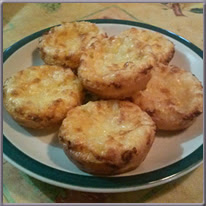
I never really got into gluten-free baking much beyond a few almond meal or coconut flour recipes.
If I needed to be gluten-free, perhaps I'd be more willing to experiment. But I did a month-long gluten-free trial and pretty much determined gluten isn't an issue for me. Of course, I greatly limit carbohydrate due to T2 diabetes, so my diet isn't exactly crammed full of gluten anyways, but the serious motivation to go gluten-free just isn't there and thus I have little interest in gluten-free baking.
People I admire do all sorts of complicated recipes involving multiple types of flour mixed together with gums to approximate gluten. It always seemed like too much work with too many unfamiliar ingredients, though I expect I might feel differently if I were celiac or had NCGS.
But one day I ran across the idea of Pão de Qeijo, which are Brazilian cheese rolls. I was attracted to the idea for two reasons, first because these are an actual traditional recipe, apparently having been made since the 1800s.
Secondly, they are made with only one gluten-free flour, tapioca flour/starch, which meant I could pick up a bag of Bob's Red Mill bag at the grocery and experiment instead of a big pile of unfamiliar ingredients most gluten-free baking seemed to call for.
January 2014 link love

Weather was the main news this month. Hubby claims the words "polar vortex" didn't exist before this month. If anyone runs across an earlier usage, let me know!
All I know for sure is everyone nearly froze their nipples off this month. Here in central PA, the cold has continued, with very few days hitting above freezing. I have no hope of pulling a leek out of my garden! And my chickens, now five months old, haven't free-ranged in weeks. (By the way, the roosters LOOK like roosters now, though no crowing has yet occurred. Keeping fingers crossed for eggs soon!)
The cold was EVERYWHERE; early in the month, a Nor'easter killed 13 folks in the eastern US; mid-month the Kỳ Sơn district in Vietnam had it's first recorded snowfall EVAH; and at the end of the month the Carolinas through Texas were bracing for ridiculous cold and snowfall, perhaps we can call this a Sou'easter.
The cold wasn't quite everywhere; Australia had a record-breaking heatwave; it would've hit 110 if they used sensible degrees, but due to metric it was only 44.
Other notable events in January 2014:
No soup for you!

You remember the Seinfeld episode...
The Soup Nazi terrorized New Yorkers, denying them his luscious soup unless they followed his soup ordering protocol EXACTLY.
"No soup for you!" he bellowed, "NEXT!"
Through a bizarre set of circumstances involving an armoire, Elaine wound up with copies of all the Soup Nazi's recipes, thus ending his monopoly and saving the people from his tyranny.
Today, I am playing the part of Elaine, bringing soup to the masses!
real food for busy women

I am starting a new series on here, inspired my friend Pat who I recently reconnected with on Facebook; thus this series is tagged "posts for Pat". Pat and I hadn't spoken in decades and in catching up, of course, I spent much time ranting about real food, because I am me. I sent links to find local farmer's markets and CSAs, to find local grass-fed meat, to find local raw milk. And when we next spoke and she told me she couldn't do this, I misheard her and answered the wrong question.
Coming from where I've been lately, due to disability and the resultant lack of income, I must stretch the heck out of my food budget in order for us to eat real food. I explained to Pat why it didn't cost more, which really wasn't her issue. Pat is in a different place in life than I am. She lives in the city and works a corporate salaried job, then spends weekends on her farm with her beloved horse Coco. While she's not rich by any means, where she is poor is not finances, but time.
When I realized how I misaddressed her concerns, I also realized I had been there. I've had the deadline that keeps you working 50-60 hours weeks, where all the grocery shopping I could do was hitting a drive-through going to and from work. Where the emergency that happened at 4 PM kept you at work hours past when the salad you brought for lunch was long gone and you could barely WAIT for a pizza or sub to be assembled on your way home. There were way too many days where even THINKING about cooking when I got home was just entirely out of the question.
The thing is women living lives like that are guilty because they feed their families out of boxes too often. Worse than living with that guilt is that the high-stress busy life REQUIRES a nutrient-dense diet to fuel it, to maintain your own health. Eating all that crap destroys health, leaving you susceptible to winding up ill.
This new series is about what one can do with EXTREMELY limited time to improve your own nutrition and better provide for your family even when life has little time for the kitchen.
menu planning with Winter Soups
So we have already covered the summary... 50+ soups, including both vegetarian and paleo soups, more than half dairy-free, more than half GAPS-friendly, just soups galore!
But I wanted to get into a bit more detail today about what is actually included in this gorgeous cookbook...
menu planning
Personally, I do my grocery shopping monthly, as I have a milkman who delivers weekly so I can avoid the store. Since every trip to the store seems to involve buying a certain amount of junk, going monthly means both limiting crappy food and saving our budget.
This time of year, we do soup at least twice weekly for dinner, with enough leftovers for the following day's lunch. So prior to my next shopping trip, I need to pick 8 soups.
Easier said than done with this overabundance of riches...
growing lettuce in winter

If you're a gardener and your seed-starting setup has room, there's no reason not to grow your own lettuce through winter. The photo shows a crop at about 4 weeks in.
Where I live now, I have very deep windowsills cause my walls are thick stone, so I have a real seed-starting station with lights in my living room.
But where I lived previously, I started seeds on a windowsill and that was just fine. Wherever you have some room is fine, as long as there is enough light.
announcing Winter Soups

As a new blogger, I just completly lucked into falling into this awesome group of bloggers on Facebook who have been unbelievably generous.
One of the first projects I joined was Community Cookbooks, based on the story of Stone Soup, a childhood folk tale illustrating the value of cooperation amidst scarcity.
If you're unfamiliar with Stone Soup, the Wikipedia version goes:
Some travelers come to a village, carrying nothing more than an empty cooking pot. Upon their arrival, the villagers are unwilling to share any of their food stores with the hungry travelers. Then the travelers go to a stream and fill the pot with water, drop a large stone in it, and place it over a fire. One of the villagers becomes curious and asks what they are doing. The travelers answer that they are making "stone soup", which tastes wonderful, although it still needs a little bit of garnish to improve the flavor, which they are missing. The villager does not mind parting with a few carrots to help them out, so that gets added to the soup. Another villager walks by, inquiring about the pot, and the travelers again mention their stone soup which has not reached its full potential yet. The villager hands them a little bit of seasoning to help them out. More and more villagers walk by, each adding another ingredient. Finally, a delicious and nourishing pot of soup is enjoyed by all.
In Community Cookbooks, instead of soup ingredients to a communal soup pot, we each provided soup recipes for a communal cookbook and thus was born our first cookbook, Winter Soups. We plan at least two additional cookbooks in the future, Naturally-Sweetened Sweets and Gluten-Free Snacks.
My recipe in Winter Soups is my Italian sausage soup, in which many pounds of vegetables wind up flavored throughout with Italian sausage. I use a sweet or mild sausage, but you can use hot/spicy if you prefer, or some of each. Either way, it's a very yummy way to get piles of veggies into your belly.
about coconut oil

Coconut oil melts at 78ºF, which means most of the time, it is solid in the home.
My house is not well air-conditioned (nor well heated for that matter!), so by mid-summer, it looks like the picture to the left, about half-melted and half-solid, forming artistic-looking shapes in the jar.
But most of the year here, it's solid, and frankly gets rather hard in winter.
In this post, I'm going to first cover the chemistry and benefits of coconut oil (with research!) and then get into practical matters such as choosing the best coconut oil, storage and cooking with coconut oil (with recipes!) and topical/cosmetic uses.
waterer for backyard chickens
waterer for backyard chickens

If you are considering backyard chickens, you have likely seen a waterer like the one pictured to the left. We had one of these with our first batch of chickens years ago, picked up at an auction for a few bucks.
There's two problems with this kind of waterer. The first problem is that chickens can poop in it. It LOOKS designed to prevent that, but it doesn't work. Chickens can poop almost anywhere, they're amazing at it. This basically means you have to clean it a couple times a day, in which case a flat tray of water is actually easier to use.
The second problem is that the waterer will freeze solid in the winter. There are heated waterers you can buy, and if your coop is located so that electricity can be run to it, you may be able to do that.
Or you can just have a very clever husband who builds the most amazing redneck solutions, which is what worked for me! MacGyver is an amateur compared to my husband (who is sexier too!)
healthy real whipped cream

I love whipped cream. Not "whipped topping" full of unhealthy fats and unpronounceable chemicals, that stuff has always tasted gross to me. But real cream, full of all the same healthy fats found in butter, whipped to soft, fluffy, decadent peaks that melt sensuously on the tongue...
If you must buy it ready-made, please buy something that actually contains full-fat cream. It will still have lots of gunky stuff, but it is at least mostly real food.
For example, Reddi-wip regular whipped cream ingredients are: cream, water, sugar, corn syrup, nonfat milk, natural & artificial flavors, mono- & di-glycerides and carageenaan (the container also contains nitrous oxide, but none is left in the whipped cream). The sugar and corn syrup are likely GMO, dried milk contains the one type of cholesterol that's actually bad for you (the oxidized stuff), natural & artificial flavorings can include all sorts of nasty chemicals, and in all my years of cooking, I've never needed to add mono- & di-glycerides or carageenaan to ANY recipe. But it is mostly cream, which beats the heck out of "whipped topping", which is a nasty-tasting, inflammatory mess.
But really, it is so easy to make at home that there's rarely a need to buy it. It takes 5-10 minutes to make yourself, and you can use grass-fed cream, so as to add significant vitamins A, D3 and K2 to the even lovelier fatty acid profile pasturing brings.
Obviously, your homemade stuff won't have non-food chemicals added. And real whipped cream is naturally so rich that very little sweetener is needed; a very tiny bit of stevia sweetens it nicely (even my husband who claims to dislike stevia enjoys my whipped cream recipes).
So homemade whipped cream can really be a healthy, nutrient-dense food!
There's two basic methods, one using a whipped cream dispenser and nitrous oxide chargers, a setup that resembles the Reddi-wip can. Or you can just use a mixer, either a stand or hand mixer.
December 2013 links

Before we get to the links, I'd like to remind you that the following occurred in December 2013:
- Nelson Mandela died on Dec 5th; the official state memorial service was held on Dec 10th and his funeral on Dec 15th.
- Queen Elizabeth pardoned Alan Turing posthumously. Turing invented computer science before there were computers and his code-breaking was pivotal in the defeat of Hitler, saving thousands of Allied lives. In 1952, the British government prosecuted him for being gay, stripped him of his security clearance and chemically castrated him, leading to his suicide. He is forgiven 101 years later, but the other 50,000 men convicted under the same statute are not yet.
- Bad month for trains: a train derailed in Bangladesh killing 3; a train in the Bronx derailed killing 4; a train in India caught fire, killing 23.
- China landed a probe on the moon, becoming the third nation to do so. It's robotic rover is walking about and sending back pictures. Go China!
sea salt

When I first joined the adrenals group, one of the things that baffled me was their insistence that one should use unrefined sea salt. As a general rule, their recommendations were science-based, but the sea salt thing was defended with lots of wacky arguments that made no sense. Eventually, I quit arguing and just decided to go with the flow since they had empirical experience that it worked. This is when I discovered that sea salt TASTES awesome.
That is still my primary reason for using it as the health-based arguments are just not very compelling. Table salt is not "bleached," it is white because pure sodium chloride is white. The minerals present in sea salt are just not very worthwhile health-wise. And while it is true that anti-caking compounds are added to many table salts; how bad that is depends on exactly what is added.
how to find healthy dinner ideas

I gave away my Joy of Cooking to a young woman a few years ago. She was one of my home health aids and learned much of what she knew about cooking from me and I gave it to her because it's so great for techniques you've never done before and ingredient information and such. And at that point in my life, I pretty much never used an actual cookbook anymore; my cookbook was Google.
Whenever I was looking for lunch ideas or healthy dinner recipes, I Googled. I had to sort through the results manually because Google doesn't understand that I don't want recipes that use canned cream-of-anything or evaporated milk.
But there's a better way to search for easy dinner recipes now!



